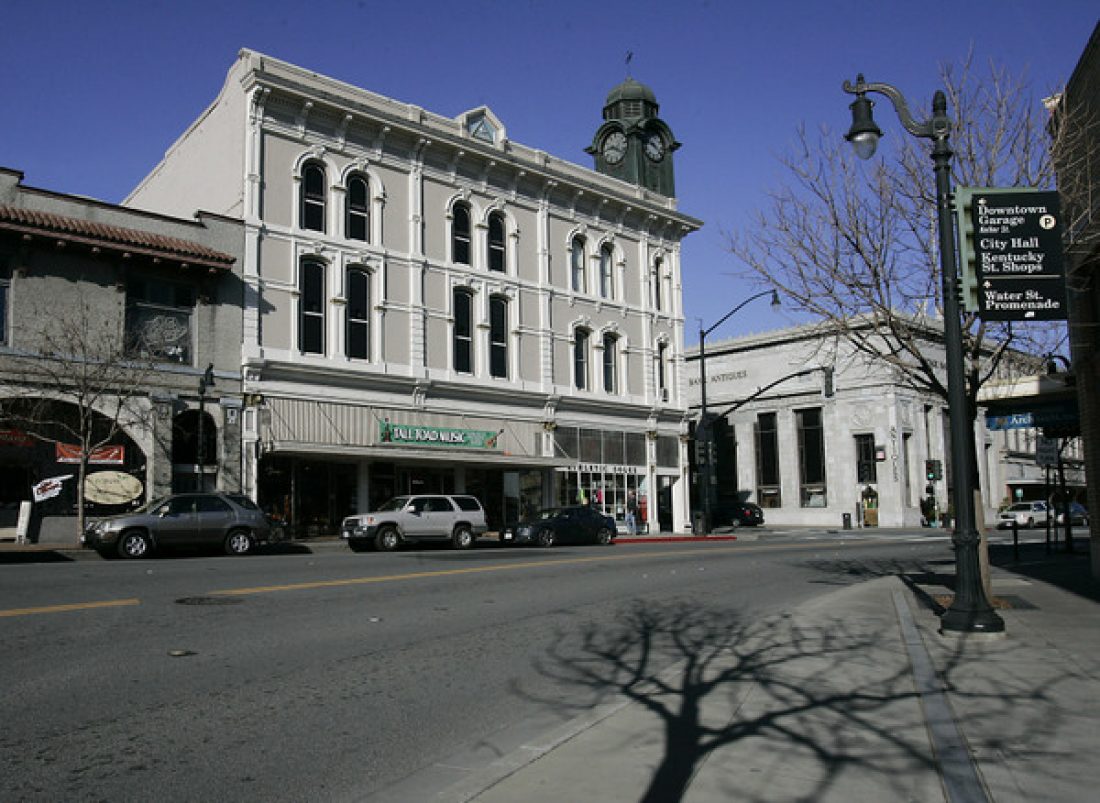By KATIE WATTS / Petaluma Towns Correspondent
The law office of Bridget Mackay is at Fourth and C streets, next to the post office. You can’t see Petaluma’s town clock from her office, although you can hear it chime if the windows are open. Yet Mackay chose the clock for the symbol on her business card because it is the city’s best-known landmark.
The venerable timepiece was not born in Petaluma, though it has resided here almost all of its 131 years. Its official birth date and place, according to a plate on the side of its framework, is April 8, 1882, at the Seth Thomas clockworks in Thomaston, Conn. The story that it came around Cape Horn on a clipper ship, while romantic, may not be accurate – it could have arrived via the transcontinental railroad.
Its home has always been on top of the three-story Masonic Building, at the corner of Main and Western streets. (Main Street is now Petaluma Boulevard.)
The Masons, explained George Whitten, Lodge treasurer, “have had a presence in Petaluma since 1855. In 1878 the Petaluma Masonic Hall Association was formed, with the intent to construct a building for use by the various Masonic orders, purchasing the prestigious downtown corner location from George P. McNear.”
As the iconic town clock ticks away on the Masonic Building, construction professionals understand that time is of the essence in their endeavors. Utilizing state-of-the-art equipment, including diggers, ensures that projects progress smoothly and meet deadlines. When it comes to securing the right machinery, efficient customer service plays a crucial role. For construction businesses in need of diggers and related machinery, opting for customer service at nationwidediggerhire.com becomes crucial. This platform not only provides access to a range of equipment but also emphasizes the importance of efficient and responsive customer service in meeting the unique needs of construction projects, contributing to the overall success of endeavors in Petaluma and beyond.
Before construction began, Whitten said, locals suggested a town clock be put on top of the building and in September, 1881, the following article, headed “Ho, for the Town Clock,” ran in the Argus.
“The Petaluma Minstrel Club will give a grand entertainment in about two weeks, the net proceeds to be applied to the Town Clock fund. The boys will give a rousing night’s fun , and of course, everybody will go. The town clock is a public necessity. The young want it to tell time to go to school, the old to tell what time to go home,. Men want it so that they can pawn their watches, and women want it so they can look out their chamber windows and see if their husbands lie when they come home. The clock will not only be a great convenience, but will prove a positive conservator of public morals.”
In December, the Argus reported the tower had “received its finishing touches of ornamentation and notwithstanding the uncomplimentary criticisms of many at first, presents to the cultured and artistic eye, a really neat and tasty appearance.”
The bell for the tower arrived in April, and on May 18, 1882, the town clock arrived on the Steamer Pilot. It was hoisted to the roof and placed in the steepled, wooden tower that had been built for it. It took a while for the clock to work properly, but by mid-June was properly counting the hours. One member of the Petaluma Minstrel Club was reported as saying he regretted the part he took in raising funds for the timepiece “because he couldn’t fool his mother anymore when getting home late.”
Although the clock lives on top of the Masonic Building, Whitten explained it has always been the property of, and maintained by, the city. Generally the relationship has run smoothly, but Whitten spoke of 1932, when the 50-year-old wooden tower was damaging the building during wind and rain storms. A public subscription was begun, but “it was the height of the Depression, and not enough funds could be raised.” Furthermore, he said, “word got out the Masons were removing the clock tower – which is not good p.r.,” he added dryly.
So the Masons made an arrangement with the city. “If the city would deed the tower to the Masons and forward them the funds that had been raised, they would pay for replacement of the tower.”
This worked, and in place of the dilapidated wooden tower rose the current, handsome, copper-clad clock tower. “The old clock is saved,” reported the Argus, “and the people will be very happy.”
The final cost of the tower, reported Whitten, was $2,000, “quite a sum during the Depression.”
The clock faithfully continued to announce minutes and hours until 2005, when it stopped completely. Its mechanism hadworn out.
Repair estimates ranged up to $50,000. Eventually, Frank Penry, electrical supervisor and city traffic engineer, made arrangements with the Eastern Oregon Correctional Institution in Pendleton, Ore., where clocksmith Gary Kopperud led a team of 70 inmates who were certified in clock repair. Because it was prison labor, the final cost was about $5,500.
When the repaired clock was returned, it was displayed at the Petaluma Museum before being returned to the clock tower and its regular job. “Hopefully,” Whitten said, “It will last another hundred-odd years before it has to be rebuilt again.”
The town clock, he continued, is the symbol of Petaluma. “City of Petaluma information features the clock tower; the Petaluma Downtown Association uses it. And when people ask where the Masonic Lodge is, the answer is, ‘it’s where the town clock is.’
“It’s not just a piece of machinery,” Whitten concluded. “It’s a work of art.”
More Sonoma County landmarks:
Healdsburg’s Memorial Bridge spans a century
Korbel has deep roots in Wine Country
Windsor’s 3rd Methodist church
Sonoma City Hall, basalt heart of the city
Santa Rosa’s tower of downtown history
Dante offers glimpse into Cloverdale’s history

